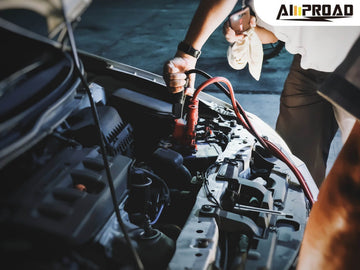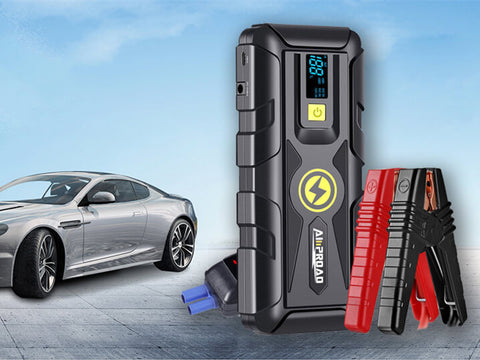
Jump-starting your car with the help of another vehicle and jumper cables is a straightforward process that can get you back on the road quickly. However, it's crucial to follow the correct steps to ensure safety and avoid damaging your car's electrical system.
Basic Knowledge of Jump Starting a Car
At its core, jump-starting a car is about transferring electrical energy from a working battery to a depleted one. This process gives your car's dead battery the jolt it needs to crank the engine and allow your vehicle's alternator to take over, recharging the battery as you drive.
While it might sound intimidating, especially if you're not mechanically inclined, jump-starting a car is actually a straightforward process. However, it's crucial to follow the correct steps to ensure your safety and avoid damaging your vehicle's delicate electrical systems.
What Will You Need for the Boosting?
Before you can play the role of automotive paramedic, you'll need to assemble your tools. Here's what you should have on hand:
- Jumper Cables: These are the lifeline of the operation. Invest in a good quality set with thick gauge wires (the lower the gauge number, the thicker the wire). Aim for cables that are at least 4 to 6 gauge and 20 feet long. This gives you flexibility in positioning the vehicles.
- A Working Vehicle: This is your "donor" car – the one with a healthy battery that will provide the jump. Ideally, it should have a similar engine size to your vehicle.
- Safety Gear: A pair of safety glasses to protect your eyes from potential battery acid splatter, and gloves to guard against electrical shock.
- Your Car's Owner's Manual: This can provide specific instructions for your make and model, especially important for newer cars with more complex electrical systems.
Positioning and Preparation
Now that you've got your tools ready, it's time to set up for the jump-start. Follow these steps for how to boost a car properly:
- Park Smart: Position the donor vehicle so that its battery is as close as possible to yours. The cars should be close enough for the jumper cables to reach but not touching. Aim for about 18 inches of space between them.
- Safety First: Both cars should be in park (or neutral for manual transmissions) with their parking brakes engaged. Turn off all lights, radio, air conditioning, and other electrical accessories in both vehicles.
- Locate the Batteries: Pop the hoods and locate the batteries in both cars. In some vehicles, especially newer models, the battery might be hidden under a plastic cover or located in the trunk. Consult your owner's manual if you're having trouble finding it.
- Identify the Terminals: On each battery, you'll see two terminals – one positive (+) and one negative (-). The positive terminal is usually larger and often marked with a red cover or a plus sign. The negative terminal is typically black or marked with a minus sign.
Connecting the Jumper Cables
This is where the rubber meets the road, so to speak. Connecting the jumper cables correctly is crucial for both safety and effectiveness. Follow these steps carefully:
- Red to Dead: Start by connecting one end of the red (positive) jumper cable to the positive terminal of the dead battery. Ensure the clamp is securely fastened to the terminal.
- Red to Donor: Take the other end of the red cable and connect it to the positive terminal of the donor car's battery. Again, make sure the connection is tight and secure.
- Black to Donor: Now, connect one end of the black (negative) jumper cable to the negative terminal of the donor car's battery.
- Black to Ground: Here's where things get a bit tricky. Instead of connecting the other end of the black cable to the dead battery's negative terminal, you'll want to find a good grounding point on the car with the dead battery. Look for a clean, unpainted metal surface in the engine bay – a bolt on the engine block or the car's frame works well. This step helps prevent sparking near the battery, which can be dangerous.
- Double-Check: Take a moment to ensure all connections are secure and that the cables aren't touching any moving parts like fan belts or pulleys.
Bringing Your Car Back to Life

With the cables properly connected, it's time to breathe life back into your vehicle:
- Start the Donor: Turn on the engine of the donor car and let it run for a few minutes. This allows its battery to transfer some charge to your dead battery.
- Rev It Up: If your car doesn't start right away, try having the person in the donor car gently rev the engine to about 1500 RPM. This increases the electrical output and can help charge your battery faster.
- Attempt to Start: Now, try jump start your car. If it doesn't turn over immediately, wait a few more minutes before trying again. Avoid cranking the engine for more than a few seconds at a time to prevent overheating the starter motor.
- Success! Once your car starts, let both vehicles run for a few minutes. This allows your car's alternator to begin recharging the battery.
- Disconnect with Care: When it's time to disconnect the jumper cables, do so in the reverse order you connected them. Start with the black cable on your car's grounding point, then the black on the donor car, followed by the red on the donor car, and finally the red on your car. Be careful not to let the clamps touch each other or any metal surfaces as you remove them.
- Keep It Running: After disconnecting, keep your car running for at least 15 to 20 minutes. This gives your alternator time to recharge the battery. Consider going for a short drive to help the process along.
When Things Don't Go According to Plan
Sometimes, despite your best efforts, your car might stubbornly refuse to start. Here are a few things to try:
- Check the Connections: Ensure all cable clamps are making good contact with the battery terminals and grounding point. Wiggle them gently to improve the connection.
- Wait Longer: If your battery is severely depleted, it might need more time to receive a charge from the donor car. Wait 5-10 minutes before attempting to start your car again.
- Rev the Donor Engine: Have the person in the donor car rev their engine slightly while you try to start yours. This can provide an extra boost of power.
- Inspect for Corrosion: If you notice a white, powdery substance on your battery terminals, this corrosion could be impeding the flow of electricity. Knowing how to clean car battery corrosion is crucial. In a pinch, you can use a wire brush or even a soft drink (the carbonation helps dissolve the corrosion) to clean the terminals.
If these steps don't work, it's possible that your battery is beyond saving or that there's another issue with your car's electrical system. In this case, it's best to call for professional help.
Avoiding Future Battery Woes
While knowing how to jump-start a car is an essential skill, it's even better to avoid dead battery situations altogether. Here are some tips to keep your battery healthy:
- Regular Maintenance: Have your battery tested annually, especially as it approaches the 3-year mark. Most auto parts stores offer this service for free.
- Keep It Clean: Regularly clean your battery terminals to prevent corrosion build-up. A mixture of baking soda and water works well for this.
- Minimize Parasitic Drain: Avoid leaving lights on or accessories plugged in when the car isn't running. These can slowly drain your battery over time.
- Drive Regularly: Short trips don't give your alternator enough time to fully recharge the battery. Try to take a longer drive (15-20 minutes) at least once a week.
- Consider a Battery Tender: If you don't drive often or store a vehicle for extended periods, a battery tender can help maintain your battery's charge.
A Final Word of Caution
While jump-starting a car is generally safe when done correctly with jumper cables or portable jump starter, it's important to remember that you're dealing with electrical systems and potentially explosive gases. Always prioritize safety:
- Never smoke near a battery, as the hydrogen gas it produces is highly flammable.
- If you notice any cracks, leaks, or bulges in either battery, do not attempt a jump-start. These could indicate a dangerous situation.
- If the battery is frozen (possible in extremely cold climates), do not attempt to jump-start it. A frozen battery can explode if jump-started.
- Always wear safety glasses to protect your eyes from potential acid splatter.
- If you're unsure about any step in the process, don't hesitate to call for professional help. It's better to be safe than sorry.
Mastering the art of jump-starting a car is a valuable skill that can save you time, money, and a whole lot of frustration. By following these steps and keeping safety in mind, you'll be well-equipped to handle one of the most common roadside emergencies. And for the more convenient option, you can keep a portable car jumper starter in your car for some possible emergency cases. Remember, practice makes perfect – consider doing a "dry run" of the process in your driveway when your battery is working fine. That way, when you're faced with a real dead battery situation, you'll be ready to spring into action with confidence.
So the next time you turn your key and hear that dreaded silence, don't panic. Take a deep breath, grab your jumper cables, and remember – you've got this! With a little knowledge and the right approach, you'll be back on the road in no time, ready to tackle whatever adventures await.


